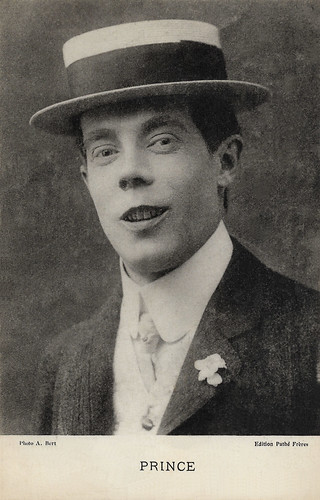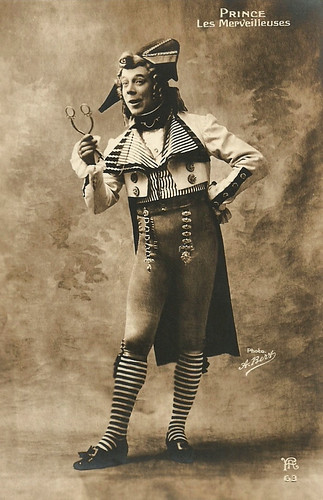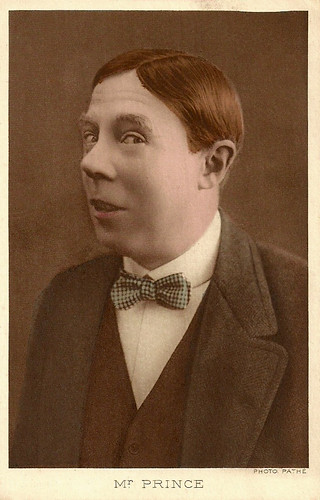
French postcard by Edition Pathé Frères. Photo: A. Bert.

French postcard by Edition Pathé Frères.

French postcard by Edition Pathé Frères. Photo: Félix.
Pathé
Charles Ernest René Petitdemange better known as Charles Prince was born at Maisons-Laffitte, France in 1872 – though some mention his birthplace as Petitdemange, near Paris. Prince’s father was a manufacturer of artificial silk and had planned for his son to study commerce and assist him. Prince chose otherwise.
He had his theatrical debut in 1896 at the Theatre de l’Odéon in the play 'La Bodinière', using a first pseudonym: Seigneur. Around the turn-of-the-century, Charles took the stage name of Prince. He became a popular boulevard theatre star, cherished for his comic performances at the Theatre des Variétés, as in Ma Tante de Honfleur.
After a decade, Pathé Frères hired him in 1908 to act in their films. Right from the beginning almost all his films were directed by Georges Monca, mostly for the Pathé subsidiary SCAGL (Société Cinématographique des Auteurs et Gens de Lettres). In 1909 Prince acted in almost 20 shorts. He co-starred with Mistinguett in Fleur de pavé/Flower pad (Michel Carré, Albert Capellani, 1909).
This number increased in 1910 when Prince introduced his character Rigadin: ¾ of his film performances that year – over 30 films - were as Rigadin. Monca directed all of the Rigadin shorts. While in 1911 Prince played in 23 Rigadin comedies, 1912 was a top year with some 45 Rigadin shorts. In 1913 Prince did 30 Rigadin shorts. In 1914 22 Rigadin films despite the outbreak of the First World War and the temporary collapse of the French film industry.
In the early 1910s, Prince and Rigadin were extremely popular throughout the world, rivalling – the now better-known - Max Linder. What both actors helped, was that they worked for Pathé Frères. Pathé was the first multinational in film history. It had a clockwork production output, massive distribution and promotion around the globe, and even its own global network of cinemas. In Germany Rigadin was known as Moritz, in Britain and the US as Whiffles, in Italy as Tartufini, in Spain as Salustiano, and in Russia as Prenz. Prince had a remarkable face with a curling lip showing his teeth and an upturned nose, for which he even mocked himself in Le Nez de Rigadin/Rigadin's Nose (1911).

French postcard by FA, no. 63. Photo: A. Bert. Publicity still for Les merveilleuses.

Spanish collectors card by Chocolate Amatller, Marc Luna, in the series Principales Artistas Cinematograficos, Serie 1a, no. 21. Photo: Félix.

French postcard by M.G., no. 514. Caption: Palais-Royal. Miss Campton.
Rigadin
As Rigadin, Prince often played the bourgeois who gets in trouble with authorities or with love interests, because of his timidity and clumsiness. Just like Prince’s previous stage performances, the Rigadin comedies thus mocked pre-war bourgeois drama and their main topic of amour, even if Prince himself occasionally acted in these bourgeois dramas as well.
In contrast to the previous anarchic comedy at Pathé and other companies, Rigadin was inspired by vaudeville and light stage comedy, and so Prince’s character stuck to ‘white collar’ respectability and convention while being pestered by mothers-in-law or his own mistresses. In Rigadin n’aime pas le vendredi 13/Rigadin does not like Friday the 13th (1911) for instance, Rigadin has dinner with his fiancée and her parents, but it is Friday the 13th and Rigadin is so superstitious that everything goes wrong.
In La Garçonnière de Rigadin (1912) Rigadin lends his bachelor flat to his future father-in-law, not knowing ‘Papa’ is going to use it for his secret rendezvous. In contrast to Linder, Prince also made Rigadin do countless transformations in all kinds of professions, from domestic, cook, chestnut seller, poet, singer and explorer to the president of the French Republic and Napoleon. In Rigadin peintre cubiste/Rigadin Cubist Painter (1912) Prince mocked avant-garde art by having Rigadin and his model wear angular clothes.
In Rigadin aux Balkans/Rigadin at the Balkan (1912) Prince played a war cameraman who fakes scenes for the camera in France. During the First World War, the number of Rigadin comedies went down from some 20 films in 1915, to 16 in 1916, 13 in 1917, and 11 in 1918. Still, Prince must have acted in some 200 shorts as of 1908, mostly Rigadin comedies.
Prince also experimented with the exchange between stage and screen. In the war revue show Nouvelle Revue, shown at the Paris Theatre Antoine in 1915, a notary Rigadin from the countryside is appalled by a film poster suggesting he has an affair with a girl and visits a Parisian cinema. There he speaks to the Rigadin on the screen, until the other turns around and starts to speak with him. When the notary tries to pursue him, he is suddenly in the film.

French postcard. Photo: Pathé. Platinogravure.

French collector's card. Large format printed publicity stills from an album of Pathé Frères films, dating 1911. Charles Prince in the French silent comedy Rigadin veut se faire arrêter (Georges Monca, S.C.A.G.L., 1911). Scripted by Gabriel Timmory. Pathé distributed the film. The film was strongly based on an earlier film with a similar plot: 'La purée veut se faire arrêter' (1908), in which a bum eats without paying thus hoping to get food and lodging at the police station. Yet, he manages to get away with it. When he suddenly gets money and orders a huge meal, the restaurant owner warns the police and our poor bum is arrested after all.
Prince pissed off by Rigadin
In all these years, the number of films in which Prince wasn’t Rigadin was really small. As of 1913, Prince acted in long(er) features as well, mostly dramas. In 1913 he thus acted opposite Léon Bernard and Suzanne Demay in the SCAGL production Les Surprises du divorce/Divorce Surprises, directed by Georges Monca.
Then followed Le Bon juge/The Good Judge, Le Coup de fouet/The Whiplash, Ferdinand le noceur/Ferdinand the playboy, Le Fils à papa/Son to dad and Monsieur le directeur/Mr. Director, all co-directed in 1913 by Monca and Prince himself. Subsequent long films were in 1914 Les Trente millions de Gladiator, Bébé, La Famille Boléro, La Femme à papa (all co-directed by Prince and Monca) and Les Fiançés héroïques (Georges Monca, 1914), in 1915 L’Auréole de la gloire and La Main dans le sac (both by Monca), in 1916 La Mariée récalcitrante (Monca, Prince).
In 1919-1921 Prince played in a few feature-length comedies, again all directed by Monca, such as Les Femmes Collantes/The sticky women (1919-1920) and Madame et son filleul/Madame and Her Godchild (1919). One last time he played in a Rigadin short, probably mocking his own dissatisfaction or that of the spectators, as the title was Prince embêté par Rigadin/Prince pissed off by Rigadin (1920).
By the early 1920s, though, not only the popularity of Rigadin but also that of Prince had faded, and for years Prince didn’t act in film anymore. In 1928, he made one last silent film, Embrassez-moi by Robert Péguy and Max de Rieux. Between 1930 and 1933, he had an active career in the early French sound cinema. He now played supporting roles, as in Maurice Tourneur’s Partir/Go (1931) and Pierre Colombier’s Sa Meilleure cliente/Her best client (1932), starring Elvire Popesco and René Lefèvre.
Then Prince died at Saint-Maur-des-Fossés, France in 1933. He was only 61. In 1910 Prince had shortly been married to vaudeville and film actress Miss (Aimée) Campton. They had one daughter Renée (1901), who died in 1993. Campton was the cousin of Paul Derval, director of the Folies-Bergères. Prince's great-grandson is French film director Cris Ubermann.

French postcard by Édition Pathé Frères. Photo: Félix.

Spanish postcard. Photo: Pathé.
Sources: Richard Abel (The Ciné Goes to Town), The Bioscope., Eva Krivanec (Theatre und Medien/Theatre and the Media), Adrien Vernardin (Le Musée du Music-Hall), various obituaries in newspapers, Bibliothèque du Film, Wikipedia (French and English), and IMDb.
2 comments:
I have a signed postcard size photograph of Charles Prince with the inscription a`mon ami Carl gamlrinius Wiffles 1913 Is this of interest to anyone
T.Allen
bonjour oui contactez moi svp
Post a Comment